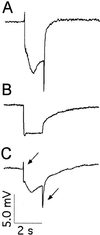Members of the synaptobrevin/vesicle-associated membrane protein (VAMP) family in Drosophila are functionally interchangeable in vivo for neurotransmitter release and cell viability
- PMID: 12364587
- PMCID: PMC129789
- DOI: 10.1073/pnas.202335999
Members of the synaptobrevin/vesicle-associated membrane protein (VAMP) family in Drosophila are functionally interchangeable in vivo for neurotransmitter release and cell viability
Abstract
Synaptobrevins or VAMPs are vesicle-associated membrane proteins, often called v-SNARES, that are important for vesicle transport and fusion at the plasma membrane. Drosophila has two characterized members of this gene family: synaptobrevin (syb) and neuronal synaptobrevin (n-syb). Mutant phenotypes and gene-expression patterns indicate that n-Syb is exclusively neuronal and required only for synaptic vesicle secretion, whereas Syb is ubiquitous and, as shown here, essential for cell viability. When the eye precursor cells were made homozygous for syb(-), the eye failed to develop. In contrast, n-syb(-) eye clones developed appropriately but failed to activate downstream neurons. To determine whether the two proteins are structurally specialized to accomplish these distinct in vivo functions, we have driven the expression of each gene in the absence of the other to look for phenotypic rescue. We find that expression of n-syb during eye development can rescue the cell lethality of the syb mutations, as can rat VAMP2 and cellubrevin. Expression of syb can restore synaptic transmission to n-syb mutants as assayed both by electroretinogram and recordings of excitatory junctional currents at the neuromuscular junction. Therefore, we find that Syb, which usually is not involved in synaptic function, can mediate Ca(2+)-triggered synaptic activity and that no particular specialization of the v-SNARE is required to differentiate synaptic exocytosis from other forms.
Figures





Comment in
-
Do SNARE proteins confer specificity for vesicle fusion?Proc Natl Acad Sci U S A. 2002 Oct 15;99(21):13359-61. doi: 10.1073/pnas.232565999. Epub 2002 Oct 8. Proc Natl Acad Sci U S A. 2002. PMID: 12374848 Free PMC article. No abstract available.
References
Publication types
MeSH terms
Substances
Grants and funding
LinkOut - more resources
Full Text Sources
Other Literature Sources
Molecular Biology Databases
Miscellaneous

